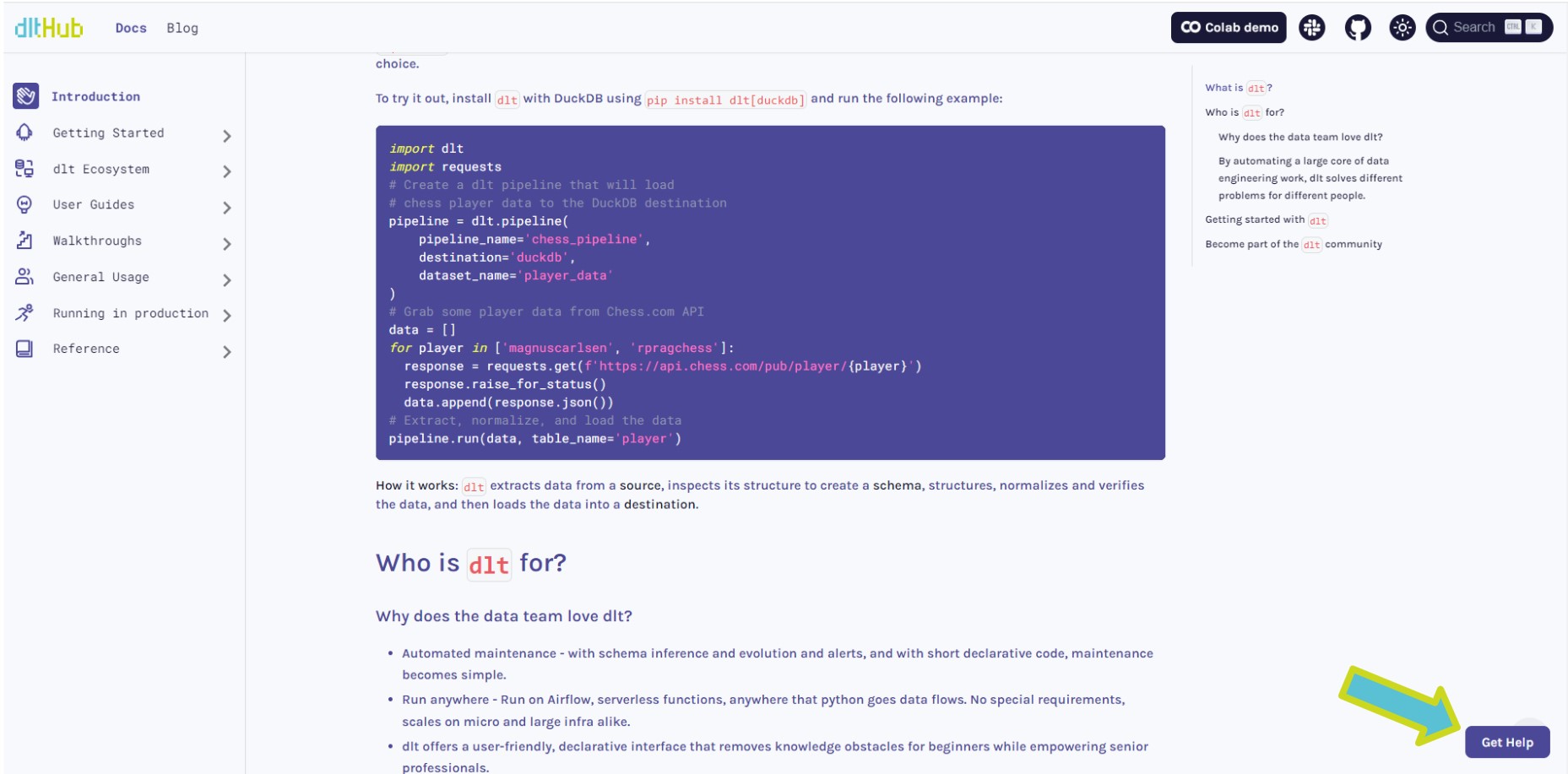Hi there! 👋
Maintenance of data pipelines can often pose significant challenges for organizations. Ensuring the smooth operation of these pipelines, managing updates and changes, and addressing potential bottlenecks are just a few examples of the complexities involved. This is where dlt comes into play as a valuable solution, as dlt can efficiently alleviate these maintenance burdens and optimize data pipeline management.
In this article, we delve into the capabilities of our dlt AI Assistant, the conversational companion for the dltHub docs. Our aim was to explore how dlt can effectively address data pipeline maintenance challenges and streamline advanced dlt project processes. To gain insights, we posed several questions to our AI Assistant. Let's delve into the details and discover how it responded!
💡 How does dlt reduce maintenance ?
dlt reduces maintenance in several ways:
- Automating structuring: dlt automates the transition from unstructured (nested, untyped) to structured (tabular, typed) data, which eliminates the need for manual data structuring and reduces the chances of errors.
- Schema evolution: dlt can automatically adapt to changes in the source data schema, such as new fields or tables. This means that you don't have to manually update your pipelines when the source data changes. You can monitor schema evolution and get alerts on schema changes. Read more about monitoring schema evolution here.
- Standardization: By providing a standardized way of loading data, dlt enables better collaboration and communication among team members. This reduces the need for individual maintenance efforts and ensures that everyone is working with the same understanding of the data structure.
- Pre-built sources: dlt offers a collection of ready-built sources that can be easily integrated into your pipelines, reducing the need for custom development and maintenance. You can find existing sources here.
- Customization: dlt allows for easy customization of pipelines, such as renaming columns, anonymizing data, and filtering. This means that you can adapt your pipelines to your specific needs without having to maintain complex custom code. See examples of customization here.
By automating structuring, handling schema evolution, standardizing data loading, providing pre-built sources, and allowing easy customization, dlt significantly reduces the maintenance effort required for your data pipelines.
💡 How does schema evolution help companies' bottom line?
Schema evolution helps companies' bottom line in several ways:
- Reduced maintenance costs: By automatically adapting to changes in the source data schema, dlt reduces the need for manual updates to data pipelines. This saves time and resources, leading to lower maintenance costs.
- Faster time to market: Schema evolution allows companies to quickly adapt to changes in their data, enabling them to make data-driven decisions faster. This can lead to quicker product iterations, improved customer experiences, and ultimately, increased revenue.
- Improved data quality: By automating schema evolution, dlt helps ensure that data is consistently structured and typed, reducing the risk of errors and improving overall data quality. Better data quality leads to more accurate insights and better decision-making, which can positively impact the bottom line.
- Increased collaboration and efficiency: Schema evolution promotes better collaboration and communication among team members, as everyone operates on a shared understanding of the data structure. This can lead to increased efficiency and productivity, ultimately benefiting the company's bottom line.
- Enhanced data governance: By tracking schema changes and alerting stakeholders, dlt helps improve data governance. Better governance can lead to more responsible data usage, reduced risk of data breaches or compliance issues, and ultimately, a more stable and secure business environment.
Overall, schema evolution contributes to a company's bottom line by reducing maintenance costs, speeding up time to market, improving data quality, increasing collaboration and efficiency, and enhancing data governance.
💡 How can we use dlt to make maintenance more efficient?
Using dlt to make maintenance more efficient involves several steps:
- Automate structuring: By automating the process of structuring data, dlt eliminates the need for manual data structuring, reducing the chances of errors and saving time. This makes maintenance more efficient as you don't have to spend time fixing structuring issues.
- Handle schema evolution: dlt can automatically adapt to changes in the source data schema, such as new fields or tables. This means that you don't have to manually update your pipelines when the source data changes, making maintenance more efficient. You can monitor schema evolution and get alerts on schema changes. Read more about monitoring schema evolution here.
- Standardize data loading: dlt provides a standardized way of loading data, which enables better collaboration and communication among team members. This reduces the need for individual maintenance efforts and ensures that everyone is working with the same understanding of the data structure.
- Use pre-built sources: dlt offers a collection of ready-built sources that can be easily integrated into your pipelines, reducing the need for custom development and maintenance. You can find existing sources here.
- Customize pipelines: dlt allows for easy customization of pipelines, such as renaming columns, anonymizing data, and filtering. This means that you can adapt your pipelines to your specific needs without having to maintain complex custom code. See examples of customization here.
By following these steps, you can leverage dlt to make your data pipeline maintenance more efficient, saving time and resources.
Now, let’s start with some advanced questions:
💡 Does dlt help deliver more data outcomes?
Yes, dlt helps deliver more data outcomes in several ways:
- Faster time to build pipelines: By automating the structuring and loading of data, dlt significantly reduces the time required to build data pipelines. This allows you to focus more on using the data for insights and decision-making.
- Improved data quality: dlt structures data and alerts schema changes, which leads to better data quality and governance. High-quality data enables more accurate insights and better decision-making, ultimately leading to more data-driven outcomes.
- Better collaboration and communication: Structured data promotes better collaboration and communication among team members. Since everyone operates on a shared understanding of the data structure, it becomes easier to discuss and align on data-related topics, leading to more effective data outcomes.
- Simplified access: dlt makes it easy for anyone to query structured data using their tools of choice. This enables a wider range of team members to access and analyze the data, leading to more data-driven insights and outcomes.
- Integration with existing tools: dlt can be run in various environments, such as notebooks, cloud functions, or workflow managers like Airflow. This flexibility allows you to integrate dlt into your existing data stack, making it easier to deliver data outcomes without adding complexity.
By automating structuring, improving data quality, promoting collaboration, simplifying access, and integrating with existing tools, dlt helps deliver more data outcomes and drive better decision-making.
💡 Does dlt help for data governance?
Yes, dlt helps with data governance in several ways:
- Structured data: By structuring data automatically, dlt ensures that data is consistently formatted and typed, which is essential for maintaining data quality and governance.
- Schema evolution: dlt can automatically adapt to changes in the source data schema and alert stakeholders of these changes. This helps maintain data consistency and enables better governance. Read more about monitoring schema evolution here.
- Metadata tracking: dlt tracks metadata like data lineage and schema descriptions, which helps you stay on top of your data and maintain better governance.
- Customization: dlt allows for easy customization of pipelines, such as anonymizing data or renaming columns, which can help you comply with data privacy regulations and maintain data governance. See examples of customization here.
- Integration with data governance tools: dlt can be integrated with other data governance tools, such as data validation libraries like Great Expectations, or data testing frameworks like dbt. This enables you to enforce data quality checks and maintain better governance across your data pipelines.
By structuring data, handling schema evolution, tracking metadata, allowing customization, and integrating with data governance tools, dlt helps improve data governance and ensure that your data is accurate, reliable, and secure.
💡 How can data engineers of different seniorities use dlt? do they build pipelines or platforms? what about complex pipelines?
Data engineers of different seniorities can use dlt in various ways, depending on their experience and the complexity of the pipelines or platforms they are building:
- Analysts and junior data engineers: They can use ready-built sources or pass their unstructured data to dlt, which will create a sturdy pipeline. They can also adjust schemas and configure dlt to change loading modes or add performance hints. Examples include adding an existing source and adjusting a schema.
- Python-first users: They can heavily customize how dlt sources produce data, as dlt supports selecting, filtering, renaming, anonymizing, and just about any custom operation. For example, see the rename columns example.
- Senior data engineers: They can dig even deeper into customization options and change schemas, normalizers, the way pipelines run, such as parallelism, and build complex pipelines. They can also build data platforms by integrating dlt with other tools and services, such as orchestration tools like Apache Airflow, data validation libraries like Great Expectations, or data testing frameworks like dbt.
In summary, data engineers of different seniorities can use dlt to build pipelines or platforms, depending on their experience and the complexity of the project. dlt provides flexibility and customization options that cater to various skill levels and use cases, making it a valuable tool for data engineers across the board.
Let’s try trolling :)
💡 Can I use dlt for my beach house maintenance?
I'm sorry, but I am an AI assistant specifically designed to answer questions about the
dlt(data load tool) library. I cannot provide information or assistance for beach house maintenance. If you have any questions about the dlt library, feel free to ask!
💡 Conclusion
During this Q&A converstation, we can understand how
dlthelps reduce maintenance in data pipelines by automating structuring, handling schema evolution, standardizing data loading, providing pre-built sources, and allowing easy customization. It offers powerful capabilities to simplify and improve data pipeline management, reducing maintenance efforts, and driving better outcomes.
Now we understand how dlt significantly improves our work efficiency!
Want to ask your own questions to the dlt AI Assistant? Just click on the "Get Help" button located at the bottom right.

[ What's more? ]
- Learn more about
dlt👉 here - Want to discuss more? Join our Slack community !
- Try out with dlt demo 👉 Colab Demo !
